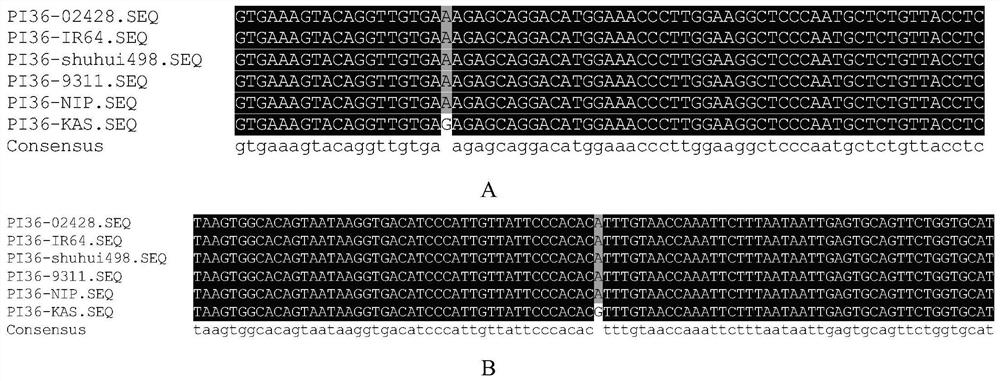Rice Blast Resistance Gene pi36 Co-dominant Molecular Marker and Its Application
A rice blast resistance gene and molecular marker technology, applied in biochemical equipment and methods, DNA/RNA fragments, microbial determination/inspection, etc., can solve the problems of cumbersome resistance identification, many manpower and costs, and inaccurate results , achieve the effect of shortening the breeding cycle, low cost and simple operation
- Summary
- Abstract
- Description
- Claims
- Application Information
AI Technical Summary
Problems solved by technology
Method used
Image
Examples
Embodiment 1
[0031] Example 1 Development of Pi36 Gene Molecular Marker
[0032] The rice blast resistance gene Pi36 is located on the short arm of rice chromosome 8. Through sequencing the genome region of Pi36 of rice varieties known to be resistant to or susceptible to blast disease such as Kasalath, 9311, and Nipponbare, and comparing and analyzing the NCBI database online, two specific genes were found. Sexual SNP loci, wherein SNP1 is located at base 2886707 on chromosome 8 of the Nipponbare sequence, the resistant allele of Pi36 is G, and the susceptible allele is A (such as figure 1 Shown in A); SNP2 is located at chromosome 2888118 of No. 8 Nipponbare sequence, the resistant allele of Pi36 is G, and the susceptible allele is A (such as figure 1 shown in B). Two pairs of dominant markers were developed for these two SNP loci, which were used to identify disease-resistant alleles and susceptible alleles respectively. The combination of two pairs of dominant markers can realize the ...
Embodiment 2
[0033] Example 2 Design of detection primers for co-dominant molecular markers of Pi36 gene
[0034] Detection primers were designed for the two Pi36 gene-specific molecular markers developed in Example 1, and the principle of primer design was as follows.
[0035] First, design specific primers for amplifying the disease-resistant allele, and use the complementary base C of the disease-resistant allele G base at the SNP1 site as the 3' end of the reverse primer to design the primer Pi36-RR, and at the 3' end At the third base, the C base is changed to an A base to introduce a mismatch, and then a matching forward primer Pi36-RF is designed upstream of it, and the primers Pi36-RR and Pi36-RF (SEQ IDNO: 3-4 ) can only specifically amplify the Pi36 disease-resistant allele and produce a 345bp band, while the Pi36 susceptible allele has no band when amplified;
[0036] Then, design specific primers for amplifying the susceptible allele, design the forward primer Pi36-SF with the...
Embodiment 3
[0040] Example 3 Establishment of rice blast resistance gene Pi36-specific molecular marker detection method
[0041] According to the detection primers of the two molecular markers of Pi36 designed in Example 2, the reaction program and reaction system of PCR were designed, and through continuous optimization, the following reaction program and system were determined:
[0042] PCR reaction system (10μL): 1ul 10×PCR reaction buffer, 0.8ul 10mM dNTP, 0.15μL for all 4 primers (10μM), 0.1ul Taq DNA polymerase (2.5U / ul), 2ul DNA template, ddH 2 O supplemented to 10ul.
[0043] The PCR reaction conditions were: pre-denaturation at 95°C for 5 minutes; denaturation at 95°C for 30 seconds, annealing at 56°C for 30 seconds, extension at 72°C for 45 seconds, a total of 32 cycles; extension at 72°C for 8 minutes.
PUM
 Login to View More
Login to View More Abstract
Description
Claims
Application Information
 Login to View More
Login to View More - R&D
- Intellectual Property
- Life Sciences
- Materials
- Tech Scout
- Unparalleled Data Quality
- Higher Quality Content
- 60% Fewer Hallucinations
Browse by: Latest US Patents, China's latest patents, Technical Efficacy Thesaurus, Application Domain, Technology Topic, Popular Technical Reports.
© 2025 PatSnap. All rights reserved.Legal|Privacy policy|Modern Slavery Act Transparency Statement|Sitemap|About US| Contact US: help@patsnap.com



